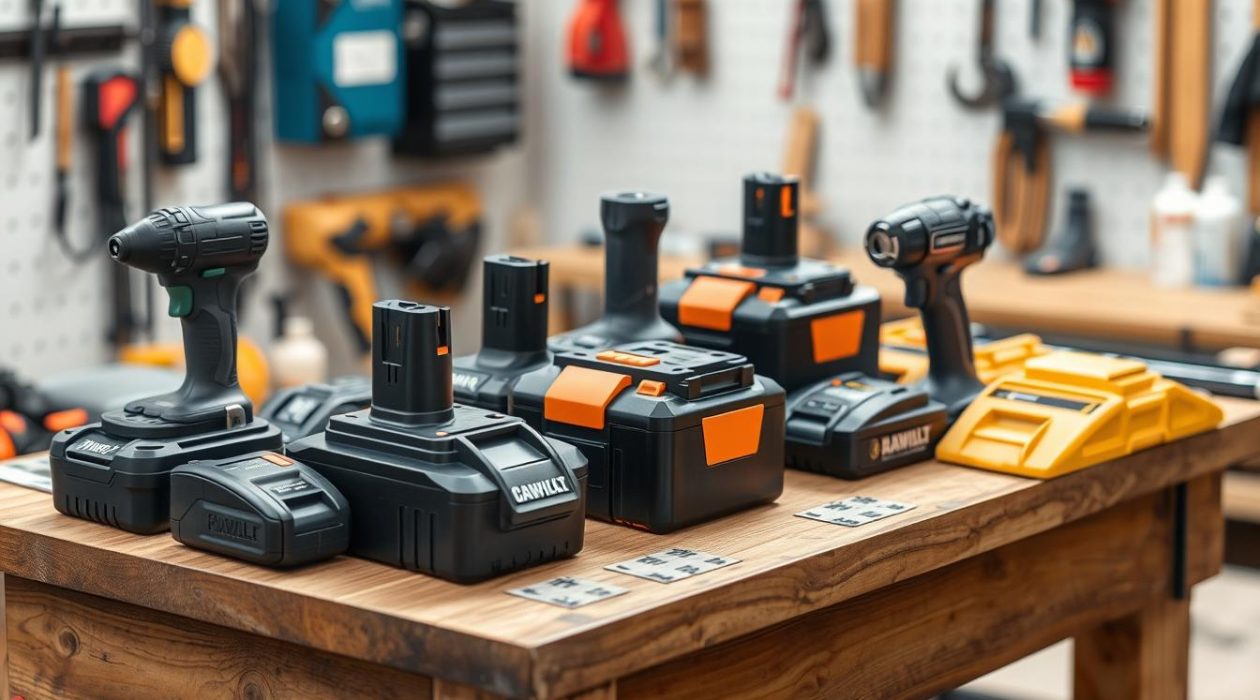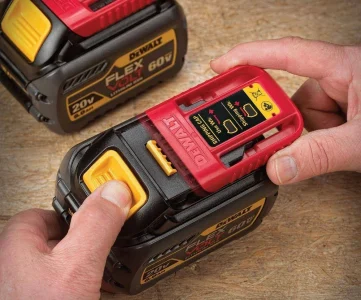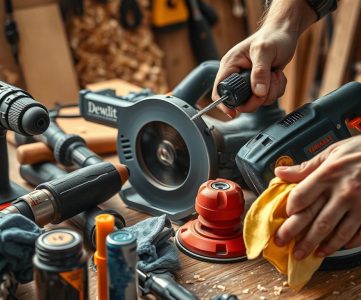Proper tool battery care is crucial for maximizing runtime and lifespan. This can save you money on replacements. By adopting the right maintenance techniques, you can extend your batteries’ life and optimize tool performance.
Understanding the significance of tool battery care and maintenance is key. It greatly impacts your tools’ performance and longevity. With the right methods, you can maintain your batteries’ health and ensure they function optimally.
Investing in learning about tool battery care and maintenance offers significant benefits. You’ll enjoy longer battery life, enhanced tool performance, and lower maintenance costs. This article will guide you on how to extend your power tool batteries’ life.
Introduction to Tool Battery Care
Tool battery care encompasses various practices and techniques to maintain battery health and performance. Proper charging, storage, avoiding overcharging, and extreme temperatures are crucial. These actions can significantly extend your batteries’ lifespan.
Key Takeaways
- Proper tool battery care can extend the life of your power tool batteries
- Power tool maintenance is essential to maximize battery runtime and lifespan
- Following the right techniques and strategies can improve tool performance and reduce maintenance costs
- Tool battery care involves proper charging, storage, and handling practices
- Understanding battery chemistry and specifications can help you make informed decisions about tool battery care
- Regular maintenance and inspection can help identify potential issues before they become major problems
Understanding Your Power Tool Batteries
To maximize your power tool’s performance, it’s vital to grasp the basics of your batteries. Cordless tool tips frequently highlight the need for the right battery match. With options like nickel-cadmium (Ni-Cd), nickel-metal hydride (NiMH), and lithium-ion (Li-ion), picking the right one can be daunting.
Understanding battery chemistry is key to effective power tool maintenance. Each chemistry has its own strengths and weaknesses. For example, lithium-ion batteries are favored for their high energy density and longevity, making them a top choice for many tools.
Different Types of Tool Batteries
- Ni-Cd: Suitable for high-drain tools, but heavy and toxic
- NiMH: Environmentally friendly, but lower energy density
- Li-ion: High energy density, long lifespan, and low maintenance
How Battery Chemistry Affects Lifespan
The chemistry of your battery significantly influences its lifespan. Opting for the correct chemistry for your tool ensures peak performance and battery longevity. Adhering to power tool maintenance and cordless tool tips can further enhance battery life.
Reading Battery Specifications
When choosing a battery, it’s crucial to examine the specifications. Look for voltage, capacity, and charging time to ensure compatibility with your tool. By following these cordless tool tips and maintaining your tools properly, you can maximize their performance and extend battery life.
| Battery Type | Voltage | Capacity |
|---|---|---|
| Ni-Cd | 12V | 2Ah |
| NiMH | 12V | 3Ah |
| Li-ion | 20V | 5Ah |
Signs of Battery Wear and Degradation
Recognizing the signs of battery wear and degradation is key to prolonging your power tool batteries’ life. Regular tool battery care helps spot potential issues before they escalate. A common indicator of battery wear is a decrease in runtime. This often stems from a reduction in the battery’s ability to hold a charge.
Another telltale sign is if your battery takes longer to charge than it used to. This could signal battery degradation. Physical damage, like cracks or dents, also indicates wear and should be checked frequently as part of your tool battery care routine.
- Reduced runtime
- Increased charging time
- Physical damage, such as cracks or dents
- Swollen or bloated battery pack
By identifying these signs early, you can take proactive measures to extend your power tool batteries’ lifespan. This ensures they continue to operate at peak performance.
Proper Charging Techniques for Maximum Lifespan
To extend the life of your power tool batteries, it’s essential to follow proper charging techniques. This includes understanding the optimal charging temperature range, avoiding overcharging, and selecting the right charger for your battery. By following these cordless tool tips, you can ensure your batteries last longer and perform at their best.
When it comes to power tool maintenance, charging your batteries correctly is crucial. Avoiding extreme temperatures is vital, as it can affect the battery’s performance and lifespan. The optimal charging temperature range is between 50°F and 90°F (10°C and 32°C). Charging your batteries within this range can help prevent damage and ensure they charge efficiently.
Optimal Charging Practices
- Avoid overcharging by removing the battery from the charger once it’s fully charged
- Use a charger specific to your battery type
- Follow the manufacturer’s charging instructions for your power tool
By following these power tool maintenance tips, you can help extend the life of your batteries and keep them performing at their best. Remember to always follow the manufacturer’s instructions and take the necessary precautions to avoid damaging your batteries.
Proper charging techniques are just one aspect of maintaining your power tools. By combining these techniques with regular maintenance and storage, you can help extend the life of your tools and ensure they continue to perform at their best.
Storage Solutions for Tool Batteries
Proper storage is key to extending your power tool batteries’ life. Store them in a cool, dry spot, away from metal to avoid short circuits. Tool battery care goes beyond just charging and using; it also means storing them right to prevent damage.
For keeping batteries clean and dry, use cases or holders made for your battery type. These protect against dust, moisture, and other environmental factors. Here are some storage tips:
- Store batteries in a cool, dry place, away from direct sunlight and heat sources.
- Use storage cases or battery holders to protect your batteries from dust and moisture.
- Avoid storing batteries in close proximity to metal objects that can cause a short circuit.
By following these simple storage tips, you can extend your power tool batteries’ life. This ensures they keep performing well. Remember, tool battery care is vital for maintaining your power tools and maximizing your investment.
Temperature Management and Protection
Proper temperature management is key to extending your power tool batteries’ life. Extreme temperatures can greatly affect their performance and longevity. To ensure they work optimally and last longer, following cordless tool tips and power tool maintenance best practices is crucial.
For heat protection, keep your batteries away from direct sunlight and high-temperature spots. Store them in a cool, dry area or use a thermal protective case. Also, avoid overcharging and use a high-quality charger to prevent overheating.
Heat Protection Strategies
- Avoid storing batteries in direct sunlight or high-temperature environments
- Use a thermal protective case to keep batteries cool
- Avoid overcharging and use a high-quality charger
Cold weather care is also vital for your batteries’ health. Storing them in freezing temperatures can cause damage and shorten their lifespan. To prevent this, store your batteries in a warm, dry place or use a battery warmer. By adhering to these cordless tool tips and power tool maintenance guidelines, your batteries will stay in good condition and perform well.
Cold Weather Care
The ideal storage temperature for your batteries is between 40°F and 80°F (4°C and 27°C). Keeping them within this range can extend their lifespan and maintain their performance.
Common Mistakes That Damage Tool Batteries
Proper tool battery care is crucial to extend your power tool batteries’ life. Many users unknowingly shorten their battery’s lifespan by making common errors. These mistakes can be prevented with a bit of knowledge and attention to detail.
Common mistakes include overcharging, deep discharging, and physical damage. Overcharging can cause the battery to overheat, shortening its lifespan. Deep discharging can make the battery lose its charge-holding ability. Physical damage, such as drops or extreme temperatures, also shortens its lifespan.
To prevent these mistakes, following proper tool battery care guidelines is essential. This means avoiding overcharging, deep discharging, and handling the battery with care. By adhering to these guidelines, you can extend your power tool batteries’ life and ensure they function optimally.
- Avoid overcharging by removing the battery from the charger when it’s fully charged
- Avoid deep discharging by charging the battery when it’s partially discharged
- Handle the battery with care to avoid physical damage
By being aware of these common mistakes and taking steps to avoid them, you can ensure your power tool batteries last longer and perform better. Proper tool battery care is key to maximizing your batteries’ lifespan and performance.
Maximizing Runtime During Use
To maximize your power tool batteries’ runtime, it’s crucial to implement effective cordless tool tips and power tool maintenance strategies. Load management is a key aspect. It involves understanding your tools’ demands and managing battery load.
Some useful load management tips include:
- Using the correct tool for the job to avoid overloading the battery
- Monitoring the battery’s state of charge to avoid deep discharging
- Implementing battery rotation strategies to ensure even wear and tear
By following these cordless tool tips and power tool maintenance best practices, you can significantly extend your power tool batteries’ runtime. Always monitor your battery’s state of charge and adjust your usage to get the most out of your tools.
Effective power tool maintenance is essential for maximizing runtime. Combining load management tips with regular maintenance ensures your power tool batteries perform optimally over time.
When to Replace Your Power Tool Batteries
Proper tool battery care is crucial to extend your power tool batteries’ lifespan. Yet, there’s a point where replacement becomes necessary. Recognizing battery failure signs is key to knowing when to swap them out.
Look out for a drop in runtime, longer charging times, and physical harm. These are clear signs your battery is on its way out. At this point, it’s time to focus on power tool maintenance and get new batteries for peak performance.
Signs of Battery Failure
- Reduced runtime
- Increased charging time
- Physical damage, such as cracks or dents
Cost-Effective Replacement Options
When it’s time to replace your batteries, look for affordable choices. Buying from reputable brands or recycling your old batteries can save money and reduce waste. It’s a smart move for your wallet and the environment.
Adhering to tool battery care and power tool maintenance practices can significantly prolong your batteries’ life. Remember, timely replacement is vital to prevent performance decline and potential tool damage.
| Battery Type | Average Lifespan | Replacement Cost |
|---|---|---|
| Ni-Cd | 2-3 years | $20-$50 |
| Ni-MH | 3-5 years | $30-$70 |
| Lithium-Ion | 5-7 years | $50-$100 |
Implementing Your Battery Care Routine
By adhering to the cordless tool tips and tool battery care strategies discussed, you can extend your power tool batteries’ lifespan. Proper charging, storage, and temperature management are crucial. They help maximize runtime and prevent the need for expensive replacements.
Establish a consistent battery care routine to keep your tools in optimal condition. Regularly check your batteries, track their charge levels, and store them in a cool, dry environment. With consistent effort, your power tools will provide reliable performance for many years.
Share your battery care techniques and experiences with us in the comments. Together, we can assist DIYers and professionals in maximizing their cordless power tool efficiency. For more detailed advice, explore our resources on battery maintenance and troubleshooting.





